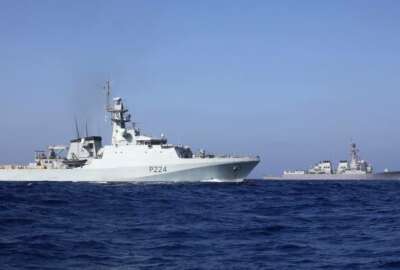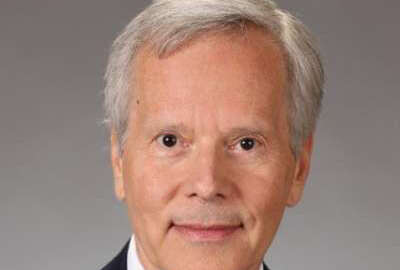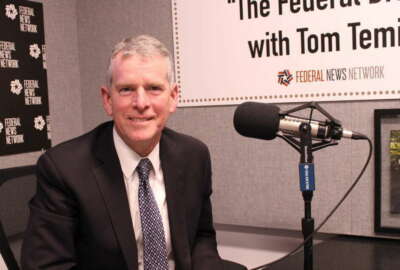
Taking control of the Naval Aviation Museum
The Naval Aviation Museum is a dream for flight enthusiasts, with everything from biplanes to Blue Angels jets. Behind the museum is a Foundation, which actively...
Best listening experience is on Chrome, Firefox or Safari. Subscribe to Federal Drive’s daily audio interviews on Apple Podcasts or PodcastOne.
The Naval Aviation Museum is a dream for flight enthusiasts, with everything from biplanes to Blue Angels jets. Behind the museum is a Foundation, which actively participates in educating potential future aviators. To learn more, Federal Drive with Tom Temin spoke with the foundation’s recently appointed CEO and President, retired Rear Adm. Kyle Cozad.
Interview transcript:
Rear Adm. Kyle Cozad: For a guy who’s been involved in aviation in uniform for over 35 years. I started in Pensacola, I ended up in Pensacola, and it was just an opportunity for me that I couldn’t turn down. And really he Naval Aviation Museum Foundation is kind of considered the sole benefactor to the National Aviation Museum. We consider ourselves the fuel that allows the museum to take flight, we support funding and we’re really focused on providing the resources to ensure that they have everything that they need to meet their strategic vision for growth today, tomorrow and in the future.
Eric White: And I’m sure you have some involvement with the actual Navy itself. What kind of collaborations will you be overseeing in your new role?
Rear Adm. Kyle Cozad: Yeah, so the coordination and the collaboration as a new retiree is to really leverage the policy decisions, garner support from the service because the Naval Aviation Museum national Naval Aviation Museum is literally the crown jewel of a family of nine or ten Navy museums around the country, we’ve got a significant population that comes in and out of the doors of the museum normally. We’ve got some challenges right now with a variety of circumstances that stem from a terrorist shooting December 6 here in Pensacola, follow that up with the COVID virus which literally shut the museum down honor about the 14th or 15th of March and then most recently Hurricane Sally. So we’ll provide all the support the museum needs, not only within Navy lines of effort, but also within corporate lines of effort for sponsorship of for funding and donations to be able to sustain as we continue to kind of dig out of the hole that 2020 has put us in.
Eric White: You really took over at quite a whirlwind of a time there. Can you get into a little bit of the specifics of the precautions that the museum is taking? What kind of stipulations are you looking at there?
Rear Adm. Kyle Cozad: Yeah, so really it’s kind of a phased opening. And we started just a few weeks ago we opened the doors to active duty personnel and their dependents and really just tried to start a trickle on. The museum has done a really good job of implementing all the national health agency precautions. We take people through, we socially distance, we make it a requirement for facemask, as folks come in the door we take temperatures, and we ensure that as they go through the museum, typically the thing that makes this museum greatness stands out is each one of the patrons gets an opportunity to go up and touch the paint and feel the aircraft. Unfortunately, with COVID we’ve kind of kind of prohibited those, those practices until we get into a better time. But we’ve got a pretty spectacular, crazy cleaning crew, that’s taken care of everything. And then really just the reduced participation and entrance. So we’re, we’re down from the the highs of typically 100 to 200,000 people a year in just starting things back up so we can kind of crawl walk and run.
Eric White: Aviators have been hard to come by or hard to keep, whether it’s Air Force or Navy, what role do you see the museum foundation actually playing in the recruitment process?
Rear Adm. Kyle Cozad: There’s a lot of things and you look back when I was a young guy, Top Gun came out. There are things that the public sees that educates them. I grew up in Las Vegas, Nevada, and I knew nothing about the Navy or naval aviation. I actually got my bug from a neighbor who was an Air Force pilot, ended up going to the Naval Academy to play basketball for a few years. And I knew that I wanted to fly so. So really, it’s an educational piece, it’s an inspirational piece, to be able to show people what naval aviation is all about– tell them the story of what it’s like to be a naval aviator or serve within aviation. Part of our job is to tell the story from a heritage perspective. And in doing so inspire folks. That dates back to the early 60s when the museum first opened its doors. And that focus was to educate young men and women at the time, just young men, who were coming to Pensacola to go to flight school, to teach them about the profession of arms and the profession of aviation that they were about to enter so they would be better prepared to become oficers, division officers and world class aviators.
Eric White: Yeah, and speaking of Top Gun, you see some of the conversation surrounding it. A lot of people say aviators in general maybe aren’t doing dogfights or anything like that anymore. What do you tell people who are interested in aviation and they’re actually looking to get a realistic perspective of what the job entails?
Rear Adm. Kyle Cozad: Yeah, it’s a good question. It’s changed in my 35 years. I have a son who flies Romeo helicopters, and he was inspired, he watched me every step of the way. And I would say that during your first decade of service, your proverbial office is the cockpit of one of the most modern sophisticated aircraft in the world, regardless of what you fly. And so the element of number one service, but also the element of excitement. The element of adventure is there. And quite frankly, it’s really unmatchable from anything that you would look at doing as you graduated from college, and any kind of desk job, etc. So aviation still offers this adventure I would say, and you tie that adventure into the fact that you’re serving your country, your nation, you’re doing your part to protect freedom and democracy. And I think it’s a pretty compelling story.
Eric White: Yeah, you may not be doing all the fighting that you see in the movies, but I mean, for God’s sakes, you’re still flying a jet, right?
Rear Adm. Kyle Cozad: Absolutely, you’re flying and you’re making a difference in your mission. So with technology, this January I believe, marks the 30th anniversary — let me double check and fact check this — but retired three star Admiral Mark Fox shot down a MiG 21. Those days are long gone. The sophistication of weapon system is beyond visual range so it’s over the horizon. So the days of World War ll where he had aces that shot down multiple airplanes , warfare is much more sophisticated to a longer range right now. And so, while it’s changed, the requirement for our pilots and our air crews to be tactically oriented, to understand everything from the mechanics of the jet that they fly to their weapon systems to adversary tactics, it’s an exciting game to play. I think it’s a a really cool opportunity here. And again, for for a guy who started — we consider Pensacola the cradle of naval aviation. So everybody who comes, you know, to fly Navy aircraft starts here in Pensacola, for as little as six weeks for up to a few years. It’s just really exciting to be part of this organization. The men and women who, who work with the museum and who worked with the foundation are passionate about what they do. And I told everybody that the coolest thing about this job is, every morning when I wake up, I wake up before my alarm goes up, because I’m so excited to get in there to learn the job and to make a difference. Everybody feels so strongly about naval aviation and what this museum brings, not only to the Navy, but to this country, it’s a special place to be.
Copyright © 2025 Federal News Network. All rights reserved. This website is not intended for users located within the European Economic Area.
Tom Temin is host of the Federal Drive and has been providing insight on federal technology and management issues for more than 30 years.
Follow @tteminWFED
Related Stories





